The Russian full-scale invasion of Ukraine has impacted every aspect of life for Ukrainians, even the date they celebrate Christmas.
What hasn’t changed is the tradition of serving 12 dishes on Christmas Eve, known as Svyata Vecherya or the Holy Supper.
Earlier this year, the Orthodox Church of Ukraine officially switched to the revised Julian calendar which celebrates Christmas on December 25th along with most Orthodox churches and Roman Catholics. The move aimed to better align with the civil Gregorian calendar and to distance itself from the Russian Orthodox Church which still celebrates Christmas on January 7th.
According to tradition, the Christmas Eve celebration begins with the appearance of the first star in the eastern sky. A wheat sheaf bouquet, known as didukh, is a custom decoration for the table.
The number of dishes still usually corresponds to the ritual number twelve, symbolizing the apostles or the months of the year. Since the meal is part of the Lenten fast leading up to Christmas, dishes do not include meat or dairy products.
The date may have changed, but much of what is served at Christmas in Ukraine has remained the same for hundreds of years. Here is a look at the 12 types of dishes found at Ukrainian tables around the world on Christmas Eve.

Kutya
Central to the festivities is Kutya — a sweet porridge made of wheat berries, barley, or rice mixed with dried fruit, nuts, poppy seeds, and honey. Some families start the evening with this dish, while others use it to end the meal.
The dish, also known as Kollyva, originates in Ancient Greece and was served in connection with the festival known as “Athnesteria” which honored Dionysius and venerated the dead.
When the Greeks converted to Christianity, the dish became associated with eternal life and immortality.
Today most Ukrainians eat the dish during the Christmas season and those observing Orthodox traditions may also serve it at funeral feasts.
RECIPE: Kutya by Natasha Kravchuk, Ukrainian-American founder of Natasha’s Kitchen and New York Times Bestselling author.
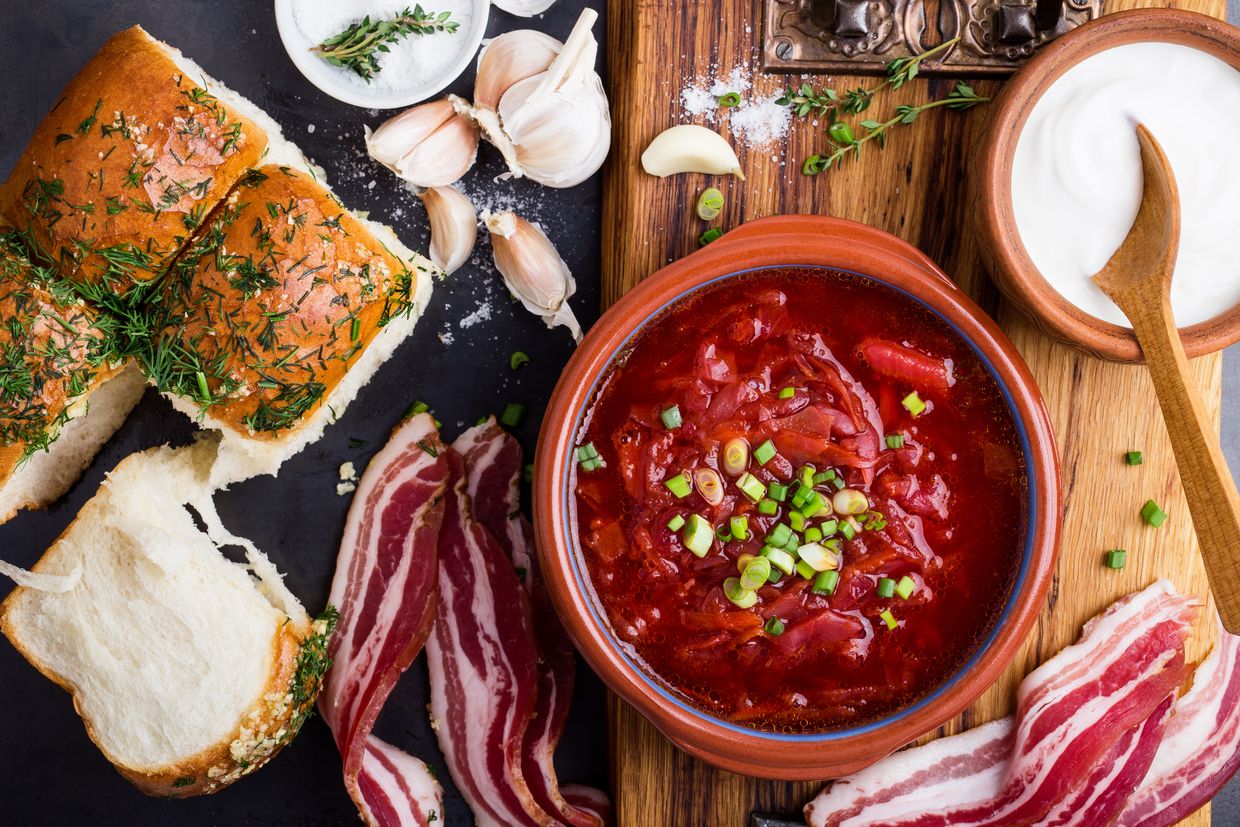
Borsch
Ukrainians have been eating and adapting borsch for at least 1,200 years. They have been serving a version that resembles the modern dish for more than five centuries. There are said to be as many versions of borsch as there are Ukrainian grandmas.
Similar to versions made during the Lenten season leading up to Easter, borsch on Christmas Eve is meat and dairy-free. Beans, mushrooms, and fish are common substitutes with some families making a “clear” version of borsch broth with the addition of vushka, or “little ear” dumplings which look similar to tortellini.
RECIPE: Hearty and flavorful vegetarian borsch by Anna Voloshyna, Ukrainian-American chef and author of BUDMO! Recipes from a Ukrainian Kitchen.
Pampushky
In Ukrainian, pampushky refers to both sweet and savory yeast-raised rolls. The term and technique are thought to be derived from the German word for pancake, pfannkuchen. They can be fried similar to donuts or baked like dinner rolls. Both versions gained popularity in the second half of the 19th century and may be found at the table on Christmas Eve.
The most common accompaniment to borsch is baked pampushky rolls topped with garlic, dill, and either butter or oil.
RECIPE: Pampushky, or Ukrainian garlic bread by Olia Hercules, activist, chef and author of cookbooks Summer Kitchens, Home Food and Mamushka.
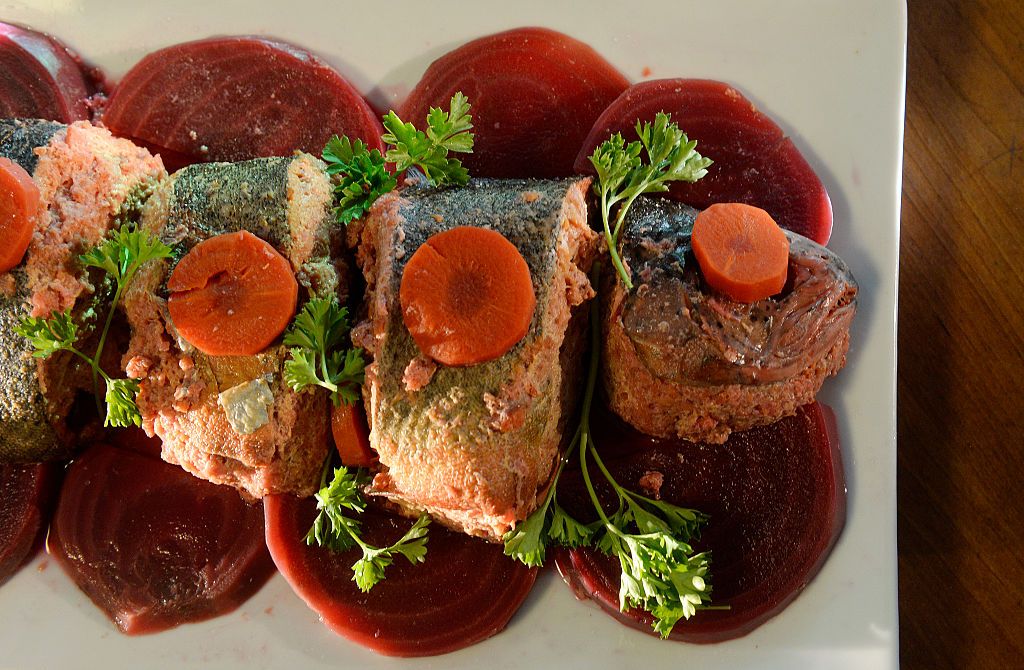
Fish
For those observing the Lenten traditions, the Christmas Eve meal should not include meat, meaning the flesh of warm-blooded animals. As fish are cold-blooded they have historically been a part of fasting meals throughout the Christian world.
Ukraine has a vast network of rivers and lakes, so fish consumption has long been ingrained in the culture. Common freshwater fish include carp, catfish, pike, and crayfish. Herring is a popular anadromous fish that spends parts of its life in both fresh and salt waters. Mackerel and hake, a more delicate member of the cod family, are saltwater fish that frequent the Ukrainian table.
Fish dishes vary widely across Ukraine with popular recipes that are baked, grilled, or fried. One popular Christmas Eve preparation is fish stuffed with a mix of ground fish and filler ingredients that is baked or poached before serving. In English, the dish is commonly known as Gefilte fish from the Yiddish word for stuffed fish.
Today, many families forgo the stuffing and simply eat minced fish in cutlet form.
RECIPES: The Ukrainian Institute’s free digital book Ukraine: Food & History by Olena Braichenko, Maryna Hrymych, Ihor Lylo, and Vitaly Reznichenko includes several holiday options for fish dishes such as Gefilte fish, minced fish cutlets with tomato and roast carp with buckwheat.
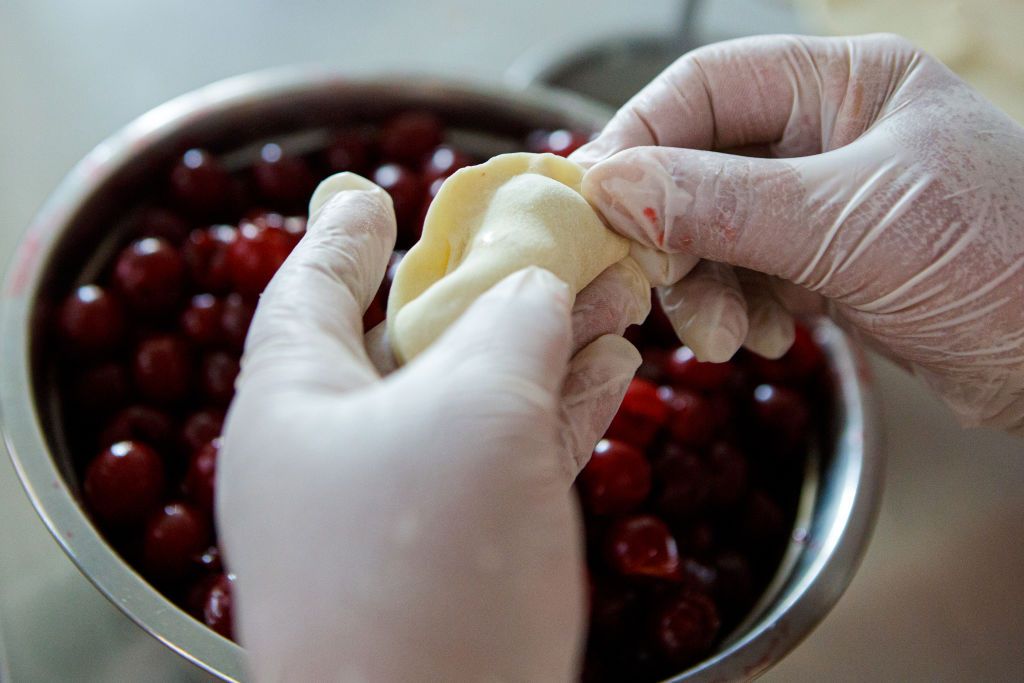
Varenyky
Varenyky, or pierogi as many people know them in North America and Europe, are dumplings that are most often filled with potato, cheese, fruits, cabbage, or mushrooms. They are usually formed by hand in a half-moon shape, boiled, then sauteed with butter or oil, and served with sour cream. Varenyky are enjoyed year-round and are a regular part of the Ukrainian diet.
RECIPE: Traditional Ukrainian Potato Varenyky by Alexandra Shytsman, Odessa-native, recipe developer, writer, and food blogger behind The New Baguette. This recipe was featured in her series, From the Motherland.
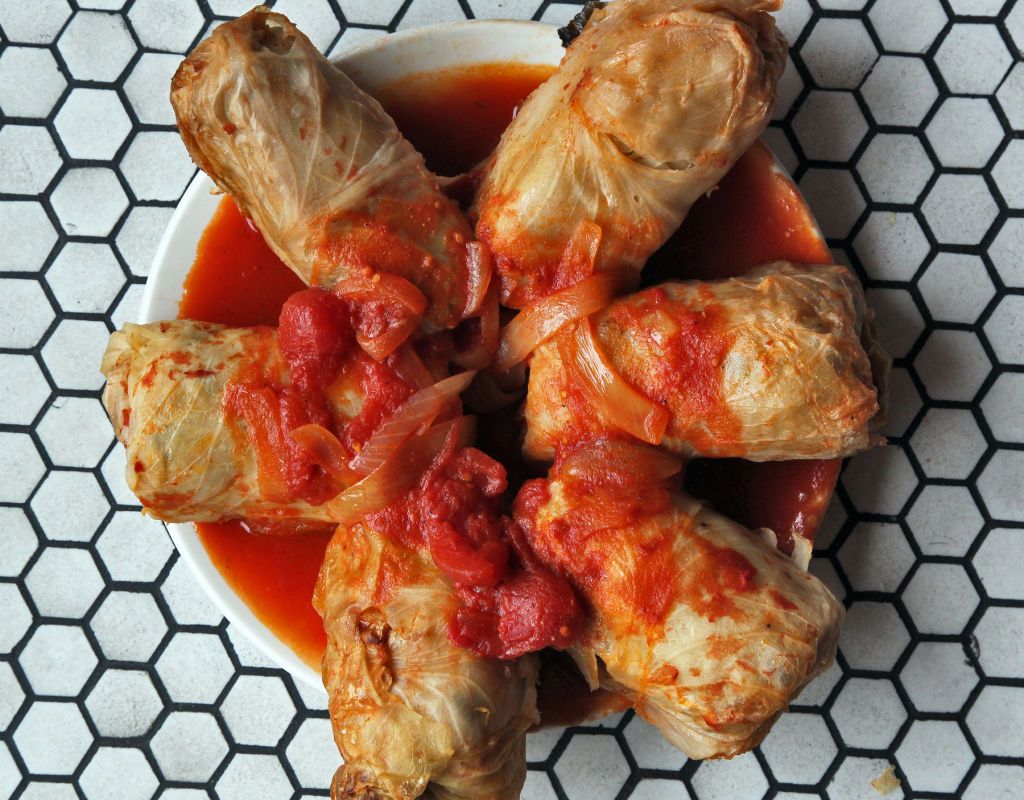
Holubtsi
Holubtsi are stuffed cabbage rolls — a dish believed to have originated during ancient times in the Middle East before spreading to Eastern Europe as various ethnic groups migrated and trade routes flourished. Today’s variations of stuffed cabbage rolls are made in at least 40 countries around the world.
The name for the Ukrainian version comes from the word for pigeon, holub. Historically pigeons were wrapped in cabbage leaves before being cooked on a spit or grilled as part of local aristocratic feasts. Once reserved for celebratory meals, over time the bird was replaced with ingredients accessible to more Ukrainians.
Today the filling is primarily grains such as rice, barley, or buckwheat mixed with a small amount of ground meat or mushrooms and minced vegetables for flavor. Most often they are wrapped in cabbage leaves and braised in a tomato-based sauce or vegetable stock.
RECIPE: Vegetarian cabbage rolls with mushrooms and barley by Anna Voloshyna, Ukrainian-American chef and author of BUDMO! Recipes from a Ukrainian Kitchen.
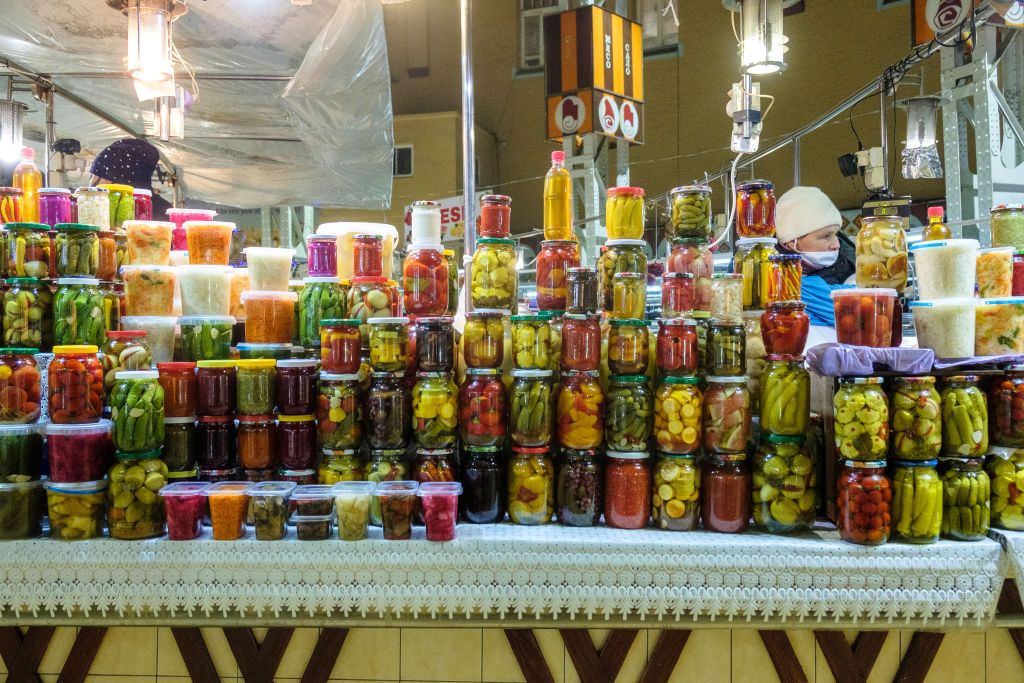
Vegetables
The 12 dishes of Christmas Eve usually include several additional vegetable-based recipes. These take many forms but are often built around mushrooms, cabbage, potatoes, and peas.
Common cold plates include pickled or fermented vegetables or chopped salads. Braised cabbage is also popular, prepared with either a tomato-based sauce or split peas.
Potatoes are used to make grated pancakes, called deruny, or mashed and formed into mushroom or vegetable-filled patties called kartoplianyky. Savory hand pies known as piroshky are filled with cabbage, mushrooms, peas, or other vegetables before being baked or fried.
RECIPES: Ukrainian braised cabbage by Ukrainian food blogger, Sava’s Kitchen and sauerkraut and split peas by Instant Ukrainian, a food blog run by a fourth-generation Ukrainian-Canadian specializing in recipes using an Instant Pot cooker.
Uzvar
Uzvar is a rich drink brewed from a combination of dried fruits including apples, plums, and apricots, and served at room temperature. Its name is derived from the Old Slavonic word, zvaryty, meaning to boil or brew. The distinct smoky flavor comes from smoked plums that also give it an amber hue.
The drink is enjoyed by Ukrainians throughout the colder months of the year. However, in the context of the Christmas Eve celebration, it is meant to symbolize spiritual birth and life.
RECIPE: The 2023 release, A Ukrainian Christmas by Nadiyka Gerbish and Yaroslav Hrytsak, includes a recipe for Uzvar that blends honey, 6 dried fruits, and 5 spices into an impressive drink for any holiday table.
Kolach Bread
Two candles are lit during the Christmas Eve celebration. One in the window to invite a passing stranger to share the holiday meal. The other is placed in the braided loaf known as kolach.
The name for the slightly sweet, braided yeast bread comes from the Old Slavonic word kolo, or circle, which symbolizes eternity. The bread is braided to commemorate the Holy Trinity and then shaped into a round loaf, an oblong loaf, or into three separate round loaves to be stacked on top of each other.
Since the bread contains eggs, it is traditionally saved to eat later on Christmas Day. According to old customs, the loaf is broken by the eldest member of the family and dipped in honey and salt before offering the greeting Christos rodyvsia meaning Christ is born. Kolach is a symbol of luck, prosperity, and a bountiful harvest.
RECIPE: Kolach Ukrainian Christmas bread from Barbara Rolek, contributing recipe writer for The Spruce Eats.












